A hybrid finite element and surrogate modelling approach for simulation and monitoring supported TBM steering
Summary (6 min read)
1. Introduction
- Mechanized tunnelling is a flexible and efficient technology for the construction of underground infrastructure, which is characterized by a dynamic technological progress of tunnel boring machines (TBMs) and an increasing range of applicability to various ground conditions [1].
- The mechanized tunnelling process involves complex spatio-temporal interactions between the TBM, the tunnel structure, the surrounding soil and the existing infrastructure.
- Numerical analyses of geotechnical problems are characterized by a large number of problem-dependent model parameters related, among others, to the geotechnical specifications of the ground.
- Surrogate models are a compact representation for the simulation model, and can be generated based on different methods, e.g. regression models, Artificial Neural Networks (ANNs), Proper Orthogonal Decomposition (POD), etc. (see [16, 17] and references therein).
- To overcome this obstacle, an approach to support the TBM steering based upon surrogate models has been proposed in a recent paper by the authors [16].
2. TBM steering concept combining surrogate models and finite element simulations
- Prior to the construction of a TBM-driven tunnel, the parameters of the tunnel boring process to be used in the project are determined in the design stage according to geological explorations to satisfy design objectives such as tolerated surface settlements, safety against loss of face stability and other specific construction requirements.
- An RNN is used for the generation of the surrogate model.
- This surrogate model-based approach for real-time steering of TBMs is illustrated in Fig. 2a.
- Using surrogate models, the process parameters are optimized in each construction step i, if the simulated settlements si exceed the tolerated settlements stol.
2.1. RNN-based surrogate model
- In [16], a procedure for the automated generation of an input set for 3D FE simulations of a straight tunnel, the data processing and the generation of a feedforward neural network-based surrogate model have been proposed.
- This method is extended to account for time-dependent processes by using RNN architectures [25].
- Figure 3 illustrates the structure of the Extended Elman’s network as proposed in [28].
- (2) The learning process is accomplished by minimizing the error in Eq. (2), where the gradient of Etot with respect to the input quantities is calculated and the weights are adjusted incrementally for both hidden and context neurons: ∆wij = −γ ∂Etot ∂wij and ∆cij = −β ∂Etot ∂cij .
2.2. Hybrid finite element and surrogate model-based steering of TBMs
- In [16], PSO is used in conjunction with computationally cheap surrogate models, which replace the original finite element model, to enable almost instantaneous back analysis of the model parameters.
- In Eq. (5), TOL is the tolerance added to avoid singularity of the solution.
- During each step, the full response of all components (soil, linings, TBM) involved in the tunnelling process can be directly accessed from the post processing of the numerical simulation.
- The hybrid FE and surrogate model-supported steering procedure is enabled by implementing the previously described RNN-PSO algorithm as a so-called OptimizationUtility in the framework of the ekate simulation model.
3. Simulation model for the Wehrhahn-line project
- A simulation model for mechanized tunnelling is generated according to project data of the Wehrhahn-line (WHL) metro project in Düsseldorf, Germany.
- For this project, a tunnelling information model has been established, which is directly interlinked with the numerical simulation model ekate via an interaction platform, which enables automated exchange of data and flexible generation of numerical models for selected sections of the tunnel project.
3.1. Tunnelling Information Model
- To store all relevant information related to the tunnelling process, to enable seamless integration of this data into the numerical simulation model, and to automate the large number of parametric analyses required for the generation of the surrogate model, a flexible information platform is required.
- This model is designed using the concept of Building Information Modeling (BIM) and contains four essential sub-models: the ground data model, the tunnel boring machine model, the tunnel lining model and the built environment model.
- These models are inherently linked and provide the basis to automatically derive numerical simulation models [30].
- For the numerical analysis, a section of the tunnel advance between two stations, namely the Schadowstraße station and Pempelforter Straße station on the eastern section of the project has been selected.
- 8 m thickness locally); alluvial layer with silt and clay deposits (thickness 0.5–1.5 m to max.
3.2. Numerical simulation model for mechanized tunnelling
- The simulation model for mechanized tunnelling ekate is generated using the object-oriented FE framework KRATOS [34].
- All relevant components of the mechanized tunnelling process (see Fig. 6) are properly modelled in this 3D FE process-oriented simulation model [27, 7] as shown in Fig.
3.2.1. Modelling of the ground
- The soft soil is modelled as a two-phase fully saturated material, accounting for the soil matrix and the pore water as distinct phases according to the theory of porous media (see [35] for details).
- For the WHL project, Drucker-Prager was used to describe the sandy soil.
- To accurately model the consolidation process, the actual time required for the excavation steps, the installation of the linings and stand still steps is considered in the set up of the simulation model for the WHL metro.
- The temporal discretization (i.e. the number and length of the increments) within each of these construction stages is adapted according to the consolidation characteristics of the soil.
- Through the simulation script, the material properties are assigned directly to the finite element mesh, storing the respective values at the element Gauss points inside of the polygon defining the respective soil layer, as illustrated in part (1) of Fig.
3.2.2. Shield machine, hydraulic jacks, lining and backup trailer
- In the simulation model ekate, the shield machine, the hydraulic jacks and the segmented lining are considered as separate components (see parts (2), (3) and (5) of Fig. 6).
- The TBM is modelled as a deformable body moving through the soil and interacting with the ground through surface-to-surface contact.
- By virtue of this modelling approach, the volume loss due to the excavation process naturally follows the real, tapered geometry and the over-cutting of the shield machine.
- The loading from the engine, the lining erector and the backup trailer are applied as surface loads.
- The hydraulic jacks are represented by truss elements tied between the lining and the shield machine.
3.2.3. Modelling of support measures
- The annular gap between the segmented lining tube and the excavation boundary is assumed to be refilled with cement-based grouting material, modelled as a fully saturated two-phase material with a hydrating matrix phase, considering the evolution of stiffness and permeability of the cementitious grout [37] (see part (4) of Fig. 6).
- To provide the stability of the tunnel face due to distortions caused by the excavation process and to reduce ground loss behind the tapered shield, the face support pressure and the grouting pressure are applied at the tunnel face and in the steering gap, respectively (see Fig. 6).
- Both support and grouting pressure are applied according to data measured during the construction phase.
- For the simulation model, only averaged values per ring are applied.
3.2.4. Modelling of existing infrastructure
- In the presented FE formulation, isotropic shell elements are adopted with respective structural properties, interacting with the soil through a mesh-independent surface-to-surface contact algorithm, which prevents the penetration of the foundation of the building into the soil (see part (6) of Fig. 6).
- It also takes different mechanisms of the soil-structure interaction corresponding to “sagging” and “hogging” modes into account.
- The geometry of the buildings is imported from the TIM as described in the following subsection and illustrated in Fig. 7.
3.3. Data exchange between the Tunnelling Information Model and the simulation model
- Using the TIM for the Wehrhahn-line, the data for the selected section of the tunnel construction site was extracted to create a simulation model.
- The selected simulation box contains the data of the topology of the subsoil including the geomechanical properties of the soil layers, existing infrastructure with material properties of substitute models for buildings [38], advance rates of the machine and the measured support and grouting pressures (see Fig. 7).
- All measured data is utilized in the stepwise simulation of the tunnelling process.
- For the generation of the surrogate model, a series of numerical simulations was performed, extracting the data from the TIM and using an automated data generator (see [16]) together with the automatic modeller ekate [39] to set up the simulation script for each individual realization.
- Execution of the numerical simulations on the available computing resources in parallel using a shared memory system based on OpenMP. Postprocessing of the simulation output.
4.1. Pre-selection of relevant parameters
- For the given range of model parameters of the investigated section of the WHL project, a sensitivity analysis has been performed to identify the most relevant model parameters needed to be updated during the TBM advancement.
- Figure 8 contains the results of a sensitivity analysis using the project data of the WHL.
- As already mentioned, the subsoil consists of three soil layers, see also Fig. 8a.
- From this graph, it can be concluded that the grouting pressure and the soil stiffness of the second layer E2 have the largest relative influence on the surface settlements.
- While in the first case, the support pressure plays an important role, in the second case, the grouting pressure becomes dominant.
4.2. Surrogate model for the metro project Wehrhahn-line
- Using the results of the sensitivity analysis, the surrogate model was created based on a reduced set of the most relevant model parameters (E1, E2, E3, γ′2, φ2 and gp ).
- In the simulation, the measured support and grouting pressure (per ring) have been used.
- The RNN surrogate model described in Section 2.1 has been trained with optimized architecture and learning rate.
- Figure 10 shows a comparison between the measurements and the prediction of the surrogate model for the settlements at the monitoring point “+” after the model parameters have been identified from the back analysis.
4.3. Model-supported steering of TBM to minimize settlements
- If surface settlements were above the critical value, the next step would be an optimization of the TBM-related parameters in order to minimize surface settlements.
- In the WHL project, surface settlements were almost negligible.
- Therefore, in the following subsection, a “worst case scenario” for the geotechnical parameters, taking the lower bounds of the ranges in Table 2 into account, is assumed to demonstrate the capabilities of the hybrid FE and surrogate model-based iterative steering of TBM parameters with the goal of minimizing the surface settlements during the TBM advance.
- To this end, a new surrogate model has been constructed with fixed values of the material parameters (lower bound of given ranges in Table 2), taking into account the variation of the support and grouting pressures scaling factors in the ranges of 0.8–1.2 and 0.6–1.2, respectively.
- The RNN surrogate model was constructed based on this data using the same procedure as described in the previous subsection, with a prediction accuracy of 98%.
4.3.1. Surrogate model-based steering
- The previously developed surrogate model-based steering strategy, similar to the approach in [16], is applied for minimization of tunnelling-induced settlements.
- Figure 11 shows the surface settlements predicted by the surrogate model for the initial values of the support and grouting pressures and the settlements after optimization of the support and grouting pressures with the objective that the maximum settlements do not exceed the limit value of 10 mm in five selected monitoring points.
- The results in Fig. 11 demonstrate the good agreement between the predictions of tunnelling-induced settlements (red line with + mark) from the RNN-PSO surrogate model and the predicted settlements (dashed line) from the 3D FE simulation model.
- Figure 11 also contains the settlements computed by the surrogate model after optimizing the TBM steering parameters (green line with × mark).
- It has to be noted that although the optimization target has been fulfilled and the maximum settlements for the first four points are kept below the limit, this has a negative effect to the ground displacement of the fifth point, where significant heaving is induced.
4.3.2. Hybrid finite element and surrogate model-supported TBM steering
- The new hybrid finite element and surrogate model-supported steering strategy proposed in Section 2.2 is applied to the same section of the WHL project as used in the previous subsection.
- After each TBM advancement step, the surface settlements are checked in all five monitoring points depicted in the upper left part of Fig. 12.
- Furthermore, it is observed from Fig. 13b that a significant drop of the optimized grouting pressure occurs after the 30th TBM advance step.
- The FE and surrogate model-supported steering shows an advantage due to the fact that the optimization is continuously supplied with the physical model response and that the steering parameters are iteratively determined based on this response.
- In Fig. 14, the deformation of a lining ring (Fig. 14a) as well as the evolution of structural forces during construction (Fig. 14b) for initial (solid lines) and optimized (dashed lines) process parameters are presented.
5. Conclusions
- This procedure was compared to a strategy recently proposed by the authors, which was completely based on surrogate models, restricting the use of the original 3D FE model to a tool for the training of the surrogate model in the design stage of the project.
- It was also shown that evidently, the response obtained from the surrogate model relies on a certain prescribed range of values for the parameters and does not provide the complete insight into the physics behind the interactions between the tunnel advancement process, the surrounding soil and the existing buildings.
- It should be emphasized that this method can be extended by adding multiple criteria for triggering and controlling the process optimization, including target parameters such as the residual safety against loss of face stability in addition to surface settlements or settlement inclinations.
- Uncertainty models such as fuzzy or combined fuzzy stochastic approaches can be incorporated in the proposed concept and may also be performed in real-time.
Did you find this useful? Give us your feedback
Figures (20)
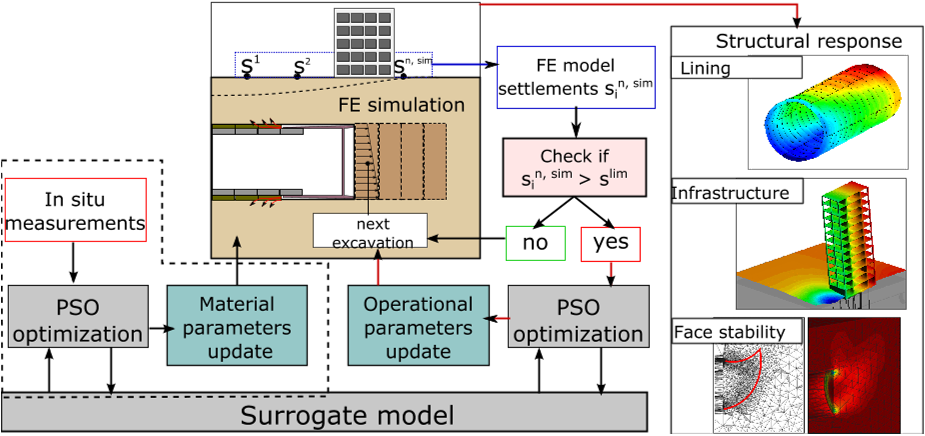
Figure 4. Hybrid FE and surrogate model-supported steering of the mechanized tunnelling process. 
Figure 7. Data exchange between the TIM and the FE simulation model ekate. 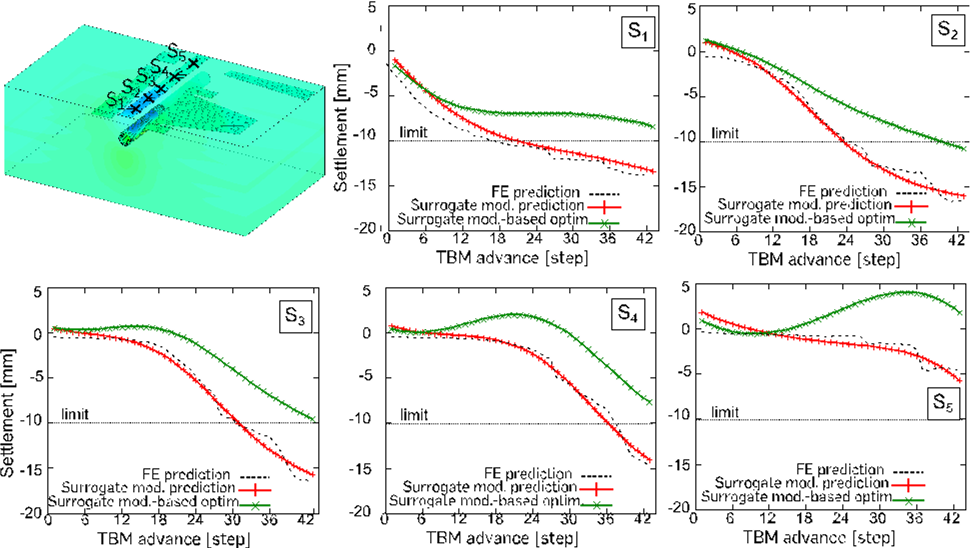
Figure 11. Model-based optimization of TBM-steering parameters: Settlements at five measurement points with and without optimized steering parameters. 
Table 4. Algorithm for model update: Identification of the soil parameters based on in situ measurements. 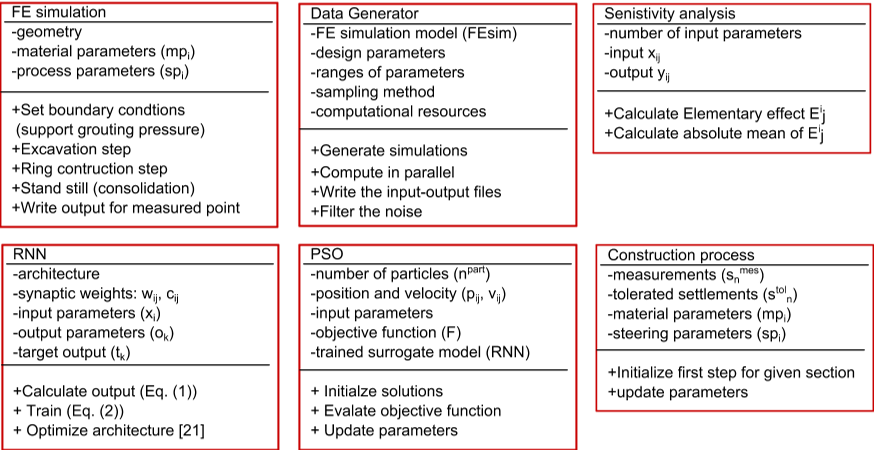
Figure 15. Main classes of the steering support tool including main objects and functions. 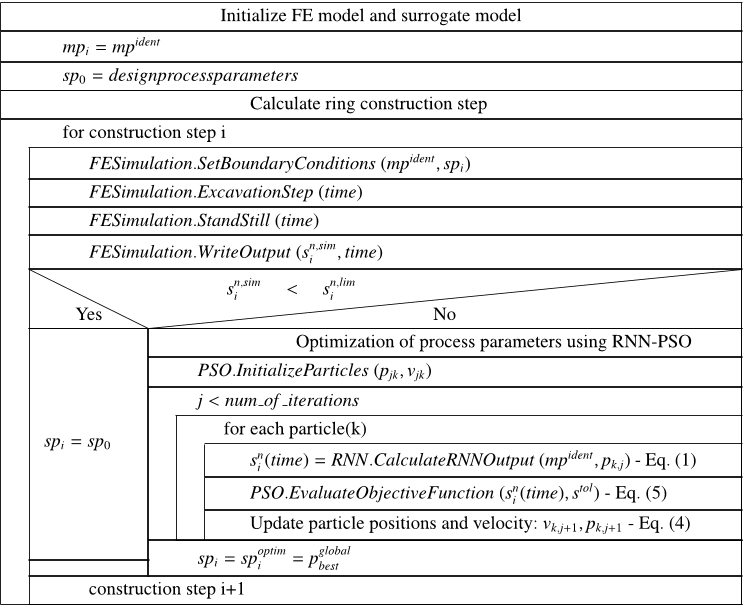
Table 1. Algorithm for the hybrid FE and surrogate model-supported steering in mechanized tunnelling 
Table 3. Algorithm for the generation of reliable surrogate models 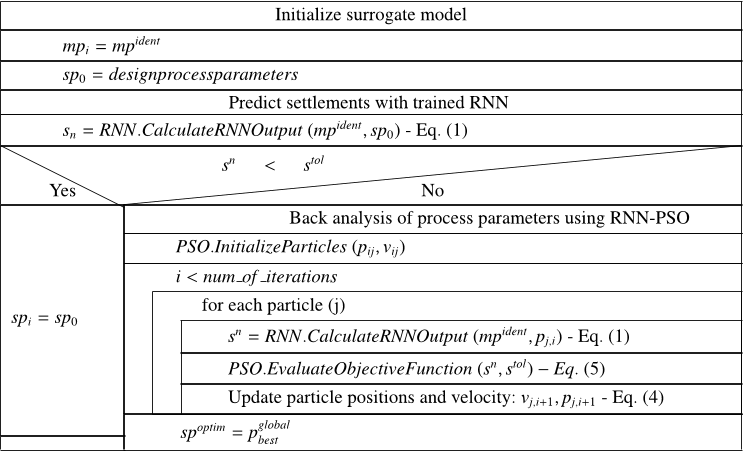
Table 5. Algorithm for surrogate model-based steering 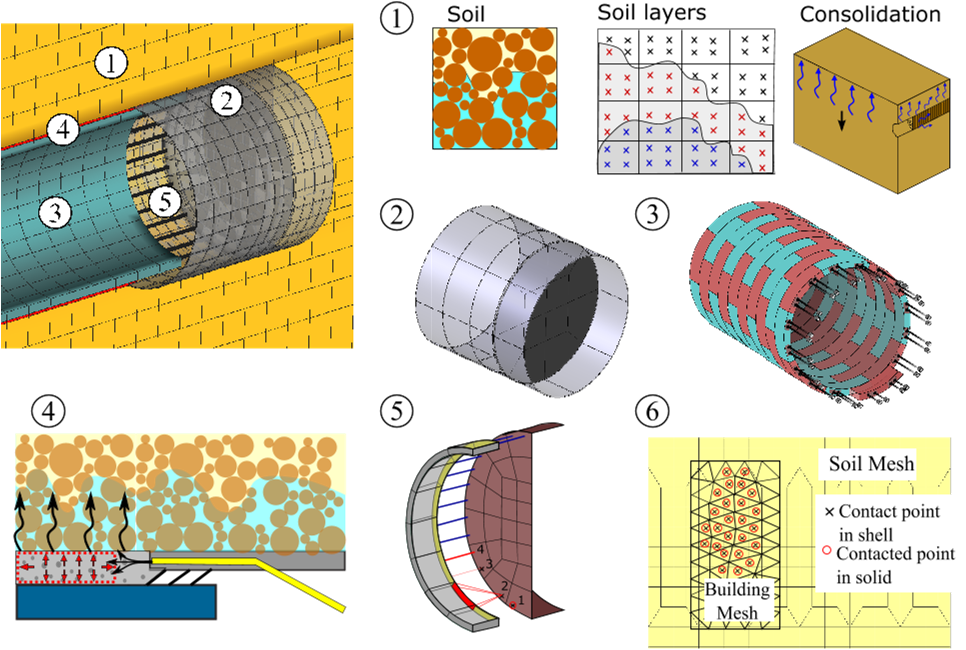
Figure 6. Process-oriented FE model for shield tunnelling ekate with relevant components: (1) Surrounding soil, definition of soil layers, consolidation; (2) TBM and frictional contact between shield skin and soil and; (3) segmented lining; (4) tail gap; (5) steering with hydraulic jacks; (6) existing infrastructure. 
Figure 10. Comparison of the settlements at the monitoring point “+” obtained from monitoring and from predictions of the surrogate model after parameter identification. 
Figure 1. Concept of the simulation-supported process control in mechanized tunnelling. 
Figure 8. Sensitivity analysis using project data of the Wehrhahn-line. a) Schematic geotechnical section of the model; b) Sensitivity measures of the model parameters w.r.t the settlements in the monitoring point in terms of |µ∗ | for the model parameters (E1, E2, E3, γ′1, γ ′ 2, φ1, φ2, c1, c2, gp, sp). 
Figure 9. a) Geometry and finite element mesh used for the generation of the surrogate model for a specific section of the WHL project; b) Comparison between settlements obtained from the FE simulation and predictions of the trained surrogate model for the training and validation sets. 
Figure 5. Tunnelling Information Model for the Wehrhahn-line in Düsseldorf: Visualization of soil layers, existing buildings, tunnel alignment, boreholes and measurement points. ![Figure 2. Strategies for the steering support of TBMs: a) Surrogate model-based steering [16]; b) Hybrid FE and surrogate model-based steering.](/figures/figure-2-strategies-for-the-steering-support-of-tbms-a-342rzq6c.png)
Figure 2. Strategies for the steering support of TBMs: a) Surrogate model-based steering [16]; b) Hybrid FE and surrogate model-based steering. 
Figure 14. a) Deformed lining ring for initial and optimized steering parameters obtained for the simulation model; b) Normal forces (N) and bending moments (M) for the selected ring in the crown, springline and invert. 
Figure 13. Temporal development of the support and grouting pressure during the hybrid finite element and surrogate model-based optimization of the TBM steering parameters. 
Table 2. Range of geomechanical and process parameters used for the analysis of the Wehrhahn-line project (in bold face: parameters used for the generation of the surrogate model). ![Figure 3. Schematic illustration of the structure of an RNN according to [28].](/figures/figure-3-schematic-illustration-of-the-structure-of-an-rnn-1fxuhiso.png)
Figure 3. Schematic illustration of the structure of an RNN according to [28]. 
Figure 12. Hybrid FE and surrogate model-supported optimization of TBM steering parameters: Settlements at five measurement points with and without optimized steering parameters.
Citations
194 citations
122 citations
43 citations
43 citations
30 citations
References
33 citations
"A hybrid finite element and surroga..." refers methods in this paper
...The cooperation with subproject D1, in which the Tunneling Information Model (TIM) was developed, is also acknowledged....
[...]
...The proposed strategy is demonstrated by means of real project data from the Tunnelling Information Model (TIM) [26] of the Wehrhahn-line (WHL) metro project in Düsseldorf....
[...]
...In order to manage the huge amount of timedependent, dispersed and heterogeneous project data, a holistic spatio-temporal Tunnelling Information Model (TIM) for mechanized tunnelling developed in [26] is used for the present project....
[...]
...The visualization of the information contained in the TIM of a WHL section is shown in Fig....
[...]
...The finite element simulation model was created based on data obtained from the TIM for a chosen tunnel section....
[...]
33 citations
26 citations
"A hybrid finite element and surroga..." refers methods in this paper
...This section has been both equipped with a sensor field and observed with radar survey to monitor the settlements during the construction phase of the tunnel [31, 32]....
[...]
23 citations
"A hybrid finite element and surroga..." refers methods in this paper
...Hybrid surrogate modelling approaches in mechanized tunnelling combining POD and ANNs are presented in [23] and [24]....
[...]
19 citations